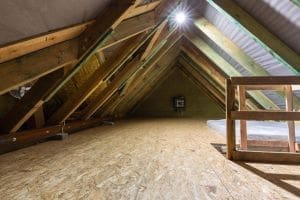
Your attic is an important part of your home’s ventilation system. Proper ventilation helps to regulate the temperature and moisture levels in your home, which can affect the performance and lifespan of your roof, insulation, and HVAC system. Proper attic ventilation also prevents the buildup of mold, mildew, and ice dams, which can damage your home and pose health risks.
But how do you know if your attic is properly ventilated? How can you tell if your attic has enough airflow to keep it cool and dry? Here are some signs that can indicate if your attic is properly ventilated or not:
– Check the temperature and humidity in your attic. You can use a thermometer and a hygrometer to measure the temperature and humidity in your attic. Ideally, the temperature and humidity in your attic should be close to the outside air. If your attic is too hot or too humid, it means that your attic is not properly ventilated and needs more airflow.
– Check the condition of your roof and insulation. You can inspect your roof and insulation for any signs of damage or deterioration caused by excess heat or moisture. For example, you can look for cracked or curled shingles, warped or rotted wood, rusted or corroded metal, sagging or wet insulation, or stains or leaks on the ceiling. If you notice any of these signs, it means that your attic is not properly ventilated and needs more airflow.
– Check for mold, mildew, or ice dams. You can look for any signs of mold, mildew, or ice dams in your attic or on your roof. Mold and mildew are fungi that grow in damp and dark places, such as your attic. They can release spores and toxins into the air that can trigger allergies, asthma, and other respiratory issues. Ice dams are thick ridges of ice that form on the edge of your roof, preventing the melted snow from draining. They can cause water damage to your roof, ceiling, and walls. If you see any mold, mildew, or ice dams, it means that your attic is not properly ventilated and needs more airflow.
If you find out that your attic is not properly ventilated, you should take action to improve your attic ventilation as soon as possible. One of the best ways to improve your attic ventilation is to install an attic ventilation fan. An attic ventilation fan is a device that helps to create a balanced airflow in your attic by drawing out the stale and hot air and bringing in fresh and cool air. An attic ventilation fan can be powered by electricity, wind, or solar energy. A solar attic fan is a type of attic ventilation fan that runs on solar energy, which is clean, renewable, and cost-effective.
Proper attic ventilation is essential for your home’s comfort, energy efficiency, and health. By checking the temperature, humidity, roof, insulation, mold, mildew, and ice dams in your attic, you can determine if your attic is properly ventilated or not. If not, you can install an attic ventilation fan to improve your attic ventilation and enjoy the benefits of a healthy and happy home.
